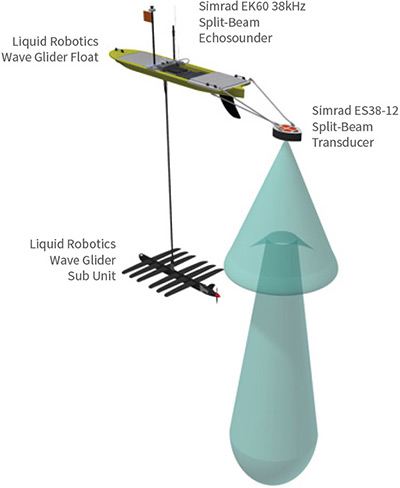Customer
Council for Scientific Industrial Research (CSIR)
Mission Location
Off the coast of South Africa
Highlights
- Gathered data to help understand and manage fisheries better
- Increased the range, frequency, and duration of monitoring
- Provided near silent operations for minimal disruption to the environment
“Wave Gliders provide a platform for gathering data over longer durations for a fraction of the cost of ships. Using fleets of Wave Gliders to better understand the health of our fisheries, could have a massive economic impact.”
The Challenge
In South Africa, the Department of Agriculture Forestry and Fisheries (DAFF) has the responsibility to determine the available fish stock levels in South Africa’s Exclusive Economic Zone (EEZ), a vast area that extends over 1.5M km2. Fishing is a vital part of many local economies and communities, but is a difficult natural resource to manage given the size of the South African EEZ, the cost of gathering data, and illegal fishing.
Acoustic fish surveys have played a critical role in both resource management, setting the annual total allowable catch (TAC) limits, and helping fishing vessels find fish. For the government, the ships used to perform these hydro acoustic surveys are resource intensive both in terms of cost and time, which limits the duration and frequency of surveys. The ability to gather fish migration data more frequently and at a lower cost could have a significant impact on both resource management and the needs of the local fishing economy.
The Council for Scientific and Industrial Research (CSIR) works closely with South African businesses and government organizations, such as DAFF, to create solutions for economic and environmental issues. With a track record of success using ocean robots and Wave Gliders for climate and fisheries research, CSIR realized an opportunity to demonstrate how Wave Gliders could augment traditional ship-based surveys of fish stock at a fraction of the cost.
The Solution
CSIR used its expertise in oceanography and developing technology for maritime applications to create a solution that would allow DAFF to perform more fishery surveys per year, while saving costs. CSIR proposed the Wave Glider platform, with ocean and weather sensors, and a SIMRAD echosounder.
Sea Technology Services (STS), a close collaborator with CSIR, performed the design, testing, and integration of the SIMRAD sensor. CSIR performed two missions for DAFF to demonstrate the capabilities of the Wave Glider.

Example of a SIMRAD echosounder integrated with the Wave Glider platform by Sea Technology Services (STS).
The Results to Date
The first successful mission took place in 2014 when the Wave Glider gathered data and detected schools of fish over a 121 km distance between Robben and Dassen Islands. A second longer mission in 2015, focused on a biomass survey and was coordinated to work in tandem with the Compass Challenger Ship that was commissioned by DAFF to undertake the fisheries survey.
According to Janet Coetzee, DAFF fisheries scientist and a specialist in the collection and analysis of hydro acoustic data, initial results have been very positive. “The data is 100% compatible,” said Coetzee*. For Coetzee the goal is to either reduce ship costs or perform surveys at times when they do not have access to a research vessel.
Coetzee sees additional applications for the Wave Glider, beyond augmenting traditional pelagic fish stock surveys. Wave Gliders could also be used to assess forage fish abundance and distribution around islands where penguins breed, helping DAFF to better manage an important breeding ground.
What’s Next?
CSIR successfully demonstrated how Wave Gliders could gather acoustic data on fish schools for a fraction of the cost of ships. The ability to gather fishery data more frequently and at a lower cost can help the government understand and manage fisheries better and could enable the local fishing industry to improve the amount of fish it catches.
The local South African fishing industry struggles to catch its annual anchovy allocation, leaving up to 200,000 tons (181,436 kg) of fish in the sea each year. Using Wave Gliders to help the government and industry better track
and manage fish stocks has real environmental and economic benefits.
CSIR sees even more opportunities for Wave Gliders given the size and importance of the South African EEZ. Wave Gliders could provide the South African Navy and DAFF with a low cost, mobile platform for 24×7 long-duration ocean monitoring to improve maritime domain awareness and enhance safety.
* Maritime Review Africa – Jan/Feb 2016, “Scientifically Speaking: Ocean Glider Show Promise”, Claire Attwood, p.9
 The goal is to integrate the two platforms ― ships and ocean robots ― to see if there’s scope for either reducing vessel costs or whether to do more surveys at times when a research vessel is not available.”*
The goal is to integrate the two platforms ― ships and ocean robots ― to see if there’s scope for either reducing vessel costs or whether to do more surveys at times when a research vessel is not available.”*